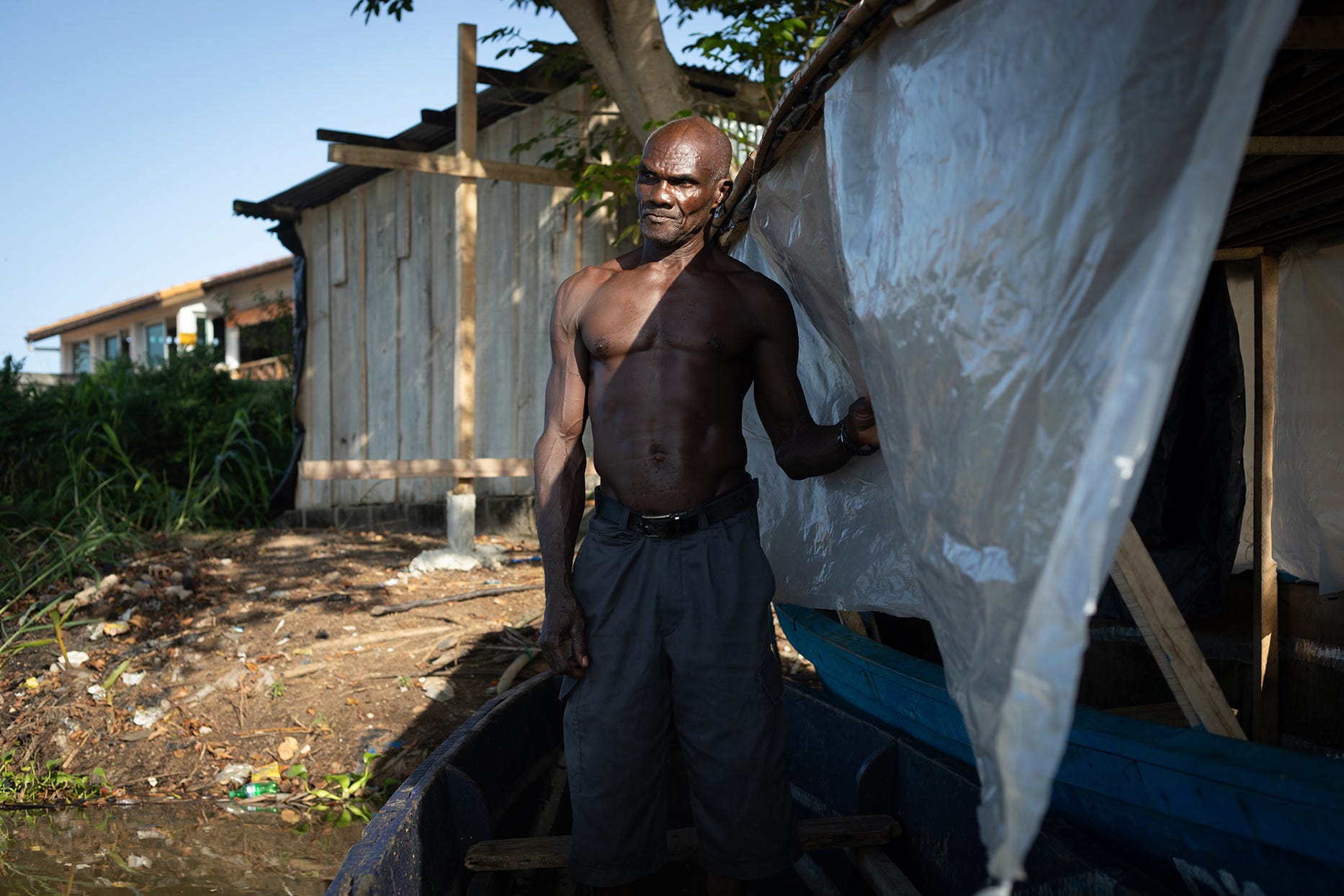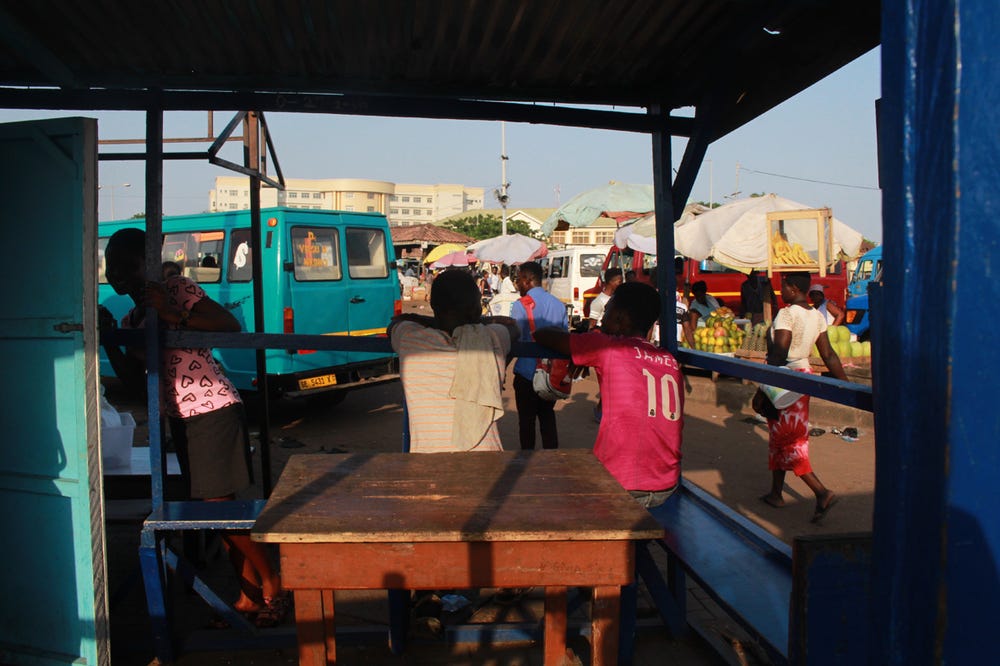A girl, a man, and a chicken pose for a photograph. They’re right in front of an entryway, framed by loose-hanging wooden beams, its borderline marked by a line of stones. It’s the opening, it seems, into a compound, where the hint of a head and the rise of a mango tree can be seen, in addition to a low fence and a washed-out wrapper. To contrast the ordinariness of the compound with the pose of the girl and man and chicken: note the confident dangle of the girl’s legs, the crisp swell of the hem of the man’s trousers, and the unfazed perch of the chicken’s toes. Note the unexpected combinations of pathos and swagger, mystery and tenderness.
Ngadi Smart: "Photography can inspire change."
This is a photo of Chat Noir, a Grand-Bassam fisherman. He stands on a boat he paid with the money he got from a company to move from his home, which was located where work is being done to help alleviate the flooding in the area. However, this improvement will likely increase value in the area, in particular the untouched natural reserves that could accommodate expensive tourist complexes.
I spent a month in Grand-Bassam, meeting the people who had been affected by the floods, setting up days to shoot them, and met Chat Noir in the process, who allowed me to photograph him in his new uprooted life.
“C’est pas Fini” (It’s Not Over) is my series for the TPA/@royalphotographicsociety Environmental Awareness Bursary on an issue impacting the historic town of Grand-Bassam, Côte d’Ivoire. Bassam is an old French-colonial seaside town which was once the nation’s capital, and is now a UNESCO World Heritage site. However its infrastructures are not maintained.
Grand-Bassam’s unprecedented extreme 2019 flooding affected the community greatly, and the threat of a return to this level of water rise is something that haunts many Bassam living people.
This year, I saw the water was starting to rise as I left in mid-September, the community hastily building barriers in the hope of keeping it at bay.
Coastal erosion, caused by climate change, is a growing problem for West African nations.
The more I took photographs and heard people’s stories, the same recurrent themes kept coming up: Lack of immediate aid during the flooding, the resilience of the people of Grand-Bassam and how they struggled to get back on their feet, and currently still try to build preventative methods in anticipation of another devastating flooding. Lastly, the pain they still carry in regards to their precious damaged property, loss of income, and the way they were left to fend for their own.
Since November 2019, a project named the PABC project, (the Cocody Bay and Ebrié Lagoon Safeguarding and Enhancement Project, executed by a company called the SGTM (Société Générale des Travaux du Maroc), has started work on the Comoé river and its sandbanks. The project aims to improve the renewal of the waters of the Ebrié lagoon by promoting the exchange between the sea and the lagoon, as well as evacuate the water and the inputs of the Comoé river towards the sea during floods.
However, the people impacted by these changes will be Bassam habitants used to living by the river, and continually so with the likely increase in value in the bay area, with its untouched natural reserves that could accommodate expensive seaside and tourist complexes. The work on the sand banks will also need to be maintained every 2 years as they are still subject to coastal erosion.
Photography can inspire change, it can change people's perceptions of others and bring light to issues which would otherwise remain in the dark. For example, think of the haunting image of David Kirby's death, taken by journalism student Therese Frare in 1990, which became an iconic image of the HIV/AIDS epidemic.
My approach to photography is very organic. It's about meeting people, making a connection, and trying to represent them in the best and most truthful way you can.
Two more photographs by Ngadi Smart
For each week’s feature, I send 3 photographs to the photographer, and ask them to respond to one. Here are the 2 other photographs I selected from Ngadi’s portfolio. What do you think about any of them? You can respond as a comment below.
Last Week — Abdullahi Ahmad
“My approach to photography has always been one of curiosity and the desire to preserve beautiful elements of cultural significance for future generations to come.
Photography is an artistic tool whose purpose is to create memories and images that can be used to tell stories in various forms. While the average person may see it as nothing more than holding a camera and pressing the shutter, this form of art has had far-reaching effects in our daily lives that we may not have noticed.”
Read “Turban and Mural.”
Thank you for reading and sharing this feature on Ngadi Smart. You can see more of her work on her website, and on Instagram.
Every week I feature one photograph and the photographer who took it. Below the photo, you’ll read a short caption from me, and a statement from the photographer. My goal is to set up conversations with the work of early to mid-career African photographers. You can support the newsletter by asking anyone—or 10 people!—interested in the impact and meanings of photography to subscribe.








Looks like the photographer is actually talking about the second photograph. But I love that because the featured photograph remains a mystery. Which is apt, given its somewhat surreal quality. Just discovered this site, and I love it. Thanks for the work of this curation.